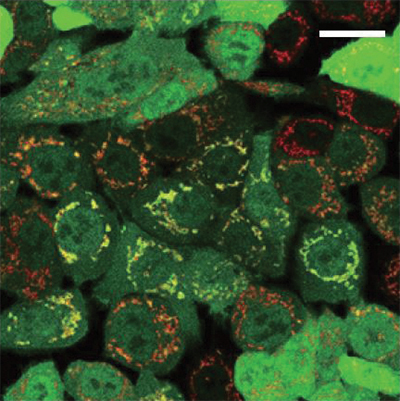JBC: Researchers link new protein to Parkinson’s
Researchers in Japan are reporting new insight into how the Parkinson’s disease-associated protein parkin selects its targets. The finding might improve experimental therapies for Parkinson’s that aim to boost parkin activity.

Cells depend on parkin to help get rid of damaged mitochondria. , published in the Journal of Biological Chemistry, suggests that parkin depends on other proteins, including one called MITOL that has not been linked previously to Parkinson’s disease, to direct it to those damaged mitochondria.
Parkin adds a degradation tag called ubiquitin to proteins on the mitochondrial surface. In some patients with familial Parkinson’s disease, parkin activity is disrupted and bad mitochondria cannot be destroyed. Harmful byproducts from those bad mitochondria can damage neurons. By understanding how parkin works and what goes wrong when it’s mutated, researchers hope also to help patients with other forms of Parkinson’s disease.
While other ubiquitin-tagging proteins, known as E3 ligases, recognize specific amino acid sequences on their substrates, parkin has many known substrates that don’t seem to share a sequence in common. While studying how parkin chooses its substrates, researchers led by Fumika Koyano in at the Tokyo Metropolitan Institute of Medical Science discovered that parkin can tag any lysine-containing protein with ubiquitin — even a bacterial protein not ordinarily found in the cell — as long as it’s present at the surface of the mitochondria.
“Parkin is not regulated by its substrate specificity,” Koyano said of the finding. Instead, control of parkin activity comes from how it is recruited and activated by other proteins.
The discovery that activated parkin is not terribly selective led Koyano and her colleagues to take a closer look at parkin’s recruitment and activation. Some details of that process are well known; for example, a protein called PINK1 is known to boost parkin activity. But Koyano and colleagues discovered a new step that must happen before PINK1 can contribute to parkin activation. They found that parkin acts more rapidly when a first ubiquitin molecule is already present, acting as a seed for the addition of more ubiquitins. In most cases, the researchers found, this seed ubiquitin is added by a protein called MITOL, which had not been linked previously to Parkinson’s.
The research could contribute to the design of new drugs, some of which aim to boost parkin activity to slow the advance of Parkinson’s disease.
“If we achieve upregulation of seed ubiquitylation on mitochondria,” Koyano said, “it might accelerate parkin recruitment and parkin activation to eliminate damaged mitochondria more efficiently.”
Enjoy reading 91”∞ø‚Today?
Become a member to receive the print edition four times a year and the digital edition monthly.
Learn moreGet the latest from 91”∞ø‚Today
Enter your email address, and we’ll send you a weekly email with recent articles, interviews and more.
Latest in Science
Science highlights or most popular articles

Hope for a cure hangs on research
Amid drastic proposed cuts to biomedical research, rare disease families like Hailey Adkisson’s fight for survival and hope. Without funding, science can’t “catch up” to help the patients who need it most.

Before we’ve lost what we can’t rebuild: Hope for prion disease
Sonia Vallabh and Eric Minikel, a husband-and-wife team racing to cure prion disease, helped develop ION717, an antisense oligonucleotide treatment now in clinical trials. Their mission is personal — and just getting started.

Defeating deletions and duplications
Promising therapeutics for chromosome 15 rare neurodevelopmental disorders, including Angelman syndrome, Dup15q syndrome and Prader–Willi syndrome.

Using 'nature’s mistakes' as a window into Lafora disease
After years of heartbreak, Lafora disease families are fueling glycogen storage research breakthroughs, helping develop therapies that may treat not only Lafora but other related neurological disorders.

Cracking cancer’s code through functional connections
A machine learning–derived protein cofunction network is transforming how scientists understand and uncover relationships between proteins in cancer.

Gaze into the proteomics crystal ball
The 15th International Symposium on Proteomics in the Life Sciences symposium will be held August 17–21 in Cambridge, Massachusetts.

